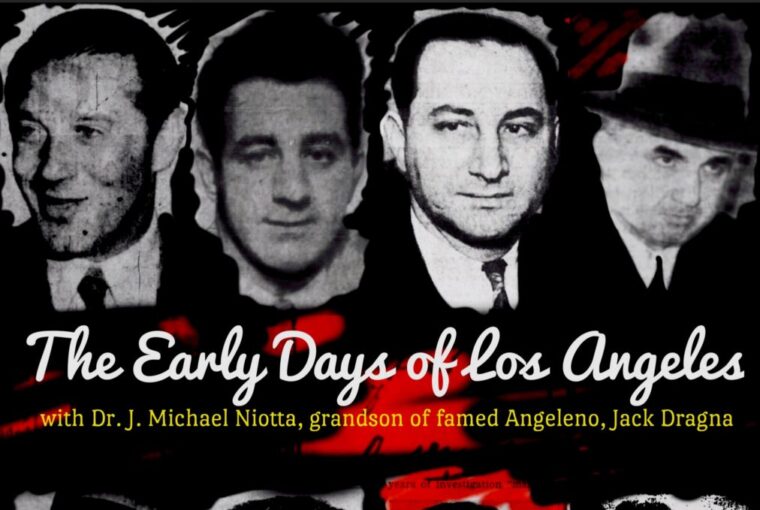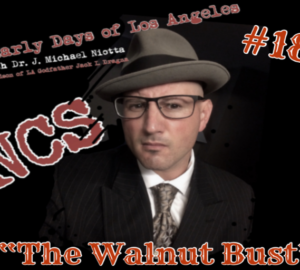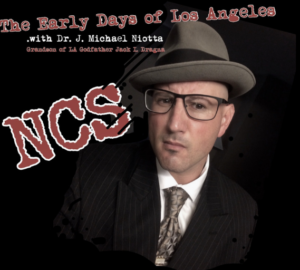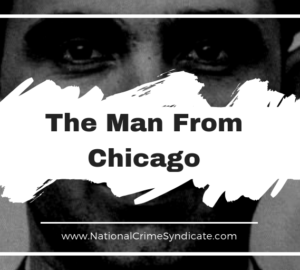9 minutes
Installment 9: The Killing of Good Time Charlie
Author’s Note: I’m looking forward to my panel on early Los Angeles mob activity at the soon coming MobWorld Summit happening this Father’s Day Weekend at the Plaza Hotel in the Las Vegas Fremont District. I hope to see you there. For the occasion of my two upcoming Vegas appearances (I will be lecturing at the Las Vegas Mob Museum as well; this September 22nd), I have compiled a “picture book” for your viewing and reading pleasure. The Little Book of Early L.A. Crime & Corruption: A Pictorial History combines twelve true crime vignettes I’ve recently penned with select original press and family photos from my personal collection. Hopefully the “little book” will be ready in time for the MobSummit.
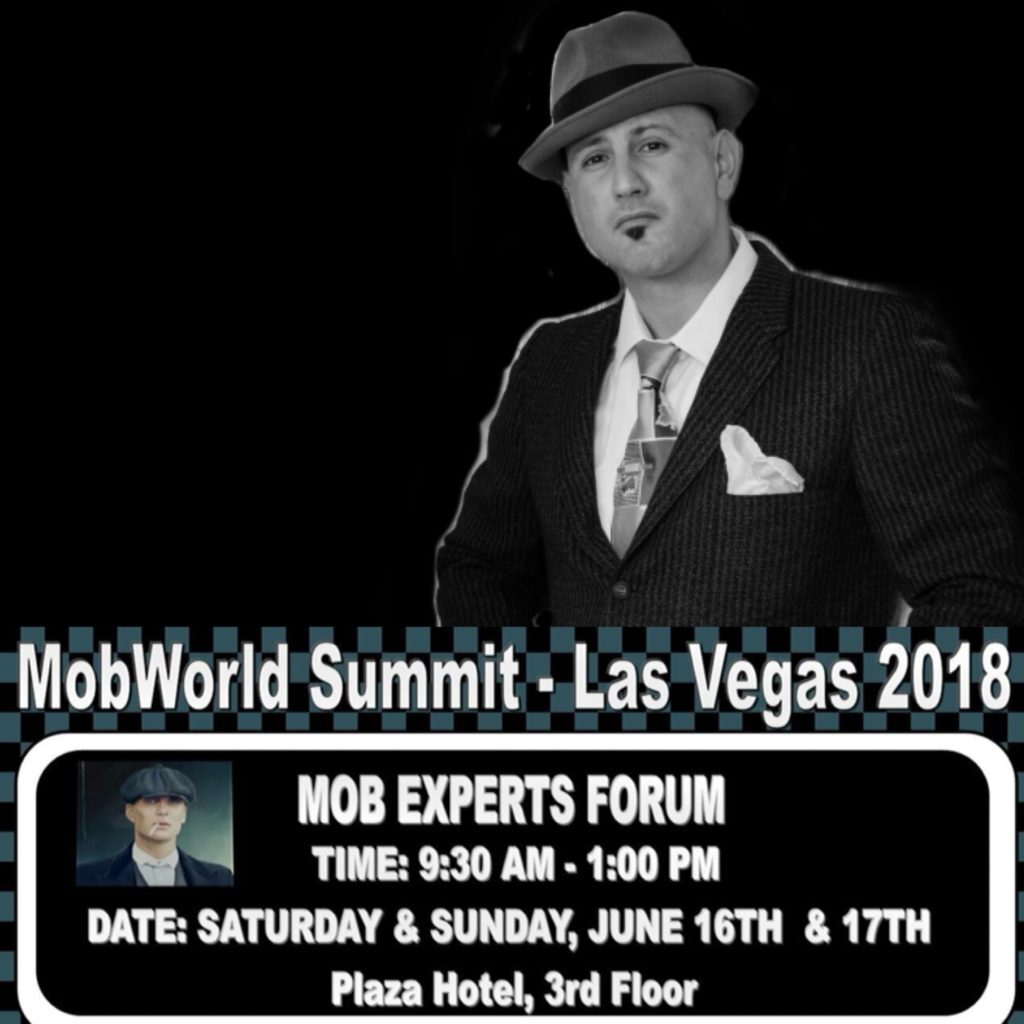
In between the slayings of cosa nostra leaders Joe “the Boss” Masseria and Salvatore Maranzano during the final moves of the American mafia’s Castellemmarese War, a political racketeer out in Los Angeles also met his end.
The Helena Daily Independent, May 24, 1931
“The Gray Wolf” Has Gone To His Reward
Los Angeles—More than a thousand persons, representing a cross section of life, gathered at St. Paul’s Presbyterian church today at final rites for Charles H. Crawford, slain in his office along with Herbert Spencer, newspaperman, Wednesday. Men of the underworld who recognized Crawford as “the Gray Wolf,” rubbed elbows with those who knew the man as a recent brother in the church—a member whose contributions totaled more than $25,000.
There were city officials, for Crawford was a power in politics. Others attended out of curiosity. Through the throng circulated detectives and officers, many friends of Crawford, for much of his power was said to have rested in police acquaintances.
“Good Time” Charlie Crawford, one of the most powerful men on the LA underworld scene during the bulk of prohibition, was more politician than bootlegger. As a leading figure of the Spring Street vice operators known as The Combination, Crawford held ties to the city’s gambling, prostitution, and bootlegging rackets. On the legal side of the house, he dabbled in real estate and insurance, though he no doubt manipulated these professions to make an easy buck as well. Crawford also owned night spots around the city, including the popular bar, the Maple. At the time of his death, the papers identified him as a financial backer of the “Critic of Critics” magazine; Spencer served as it’s Managing Editor. The voice of the press would be the beacon of their undoing.
Oddly enough, Crawford found religion late in his criminal career. While making large donations to the church, he simultaneously awaited the sentence he’d receive for his part in the Julian oil scandal. It wasn’t long after D.A. Buron Fitts cleared Crawford of the charges that a gunman paid him a visit. Had he truly “stepped away” and let his former allies enjoy their rackets, Crawford may have lived a good while longer. Instead, Good Time Charlie made a play to topple his old crime partners.
It was the twentieth of May, 1931, just before dinner. Roughly 4:30. Whoever pulled the trigger timed their visit right. Shots rang loud a short while after Crawford’s bodyguard, his brother George, stepped away to grab a bite.
Killer Escapes
The killer ran from the stuffy little room, dashed out a side door, reached the end of the covered porch and jumped down the steps. Behind him, reeling, came Spencer. Down the side of his white shirt ran a stream of blood. He ran bareheaded, stumbled off the side porch and lurched toward the high grey walls of the Church of the Blessed Sacrament, 50 feet away. “Where did that guy go?” He muttered, fell to the pavement and died.
Hearing the shots, George raced back to the office at 6665 Sunset Blvd. It was already too late. He found his brother half-dead and leaning over a chair. Taking a round to the chest, journalist Herbert Spencer died rather quickly. Good Time didn’t go so easy. A blood transfusion at Georgia Street Receiving Hospital only prolonged what was coming. Plowing through his gut, the bullet ruptured a liver and kidney. There wasn’t much hope of fixing that.
Likely in a confused state, when nurses at the “police hospital” asked if he knew who he was, he gasped, “Wilson Henry.” Though conscious, Crawford refused to name the culprit that gunned him down. When questioned, police decided he was trying to “cover up the identity of the shooter.” Stubbornly, he mouthed something to the tune of, “If I die, the secret goes with me to the grave.” They pronounced him cold at 8:54 pm.
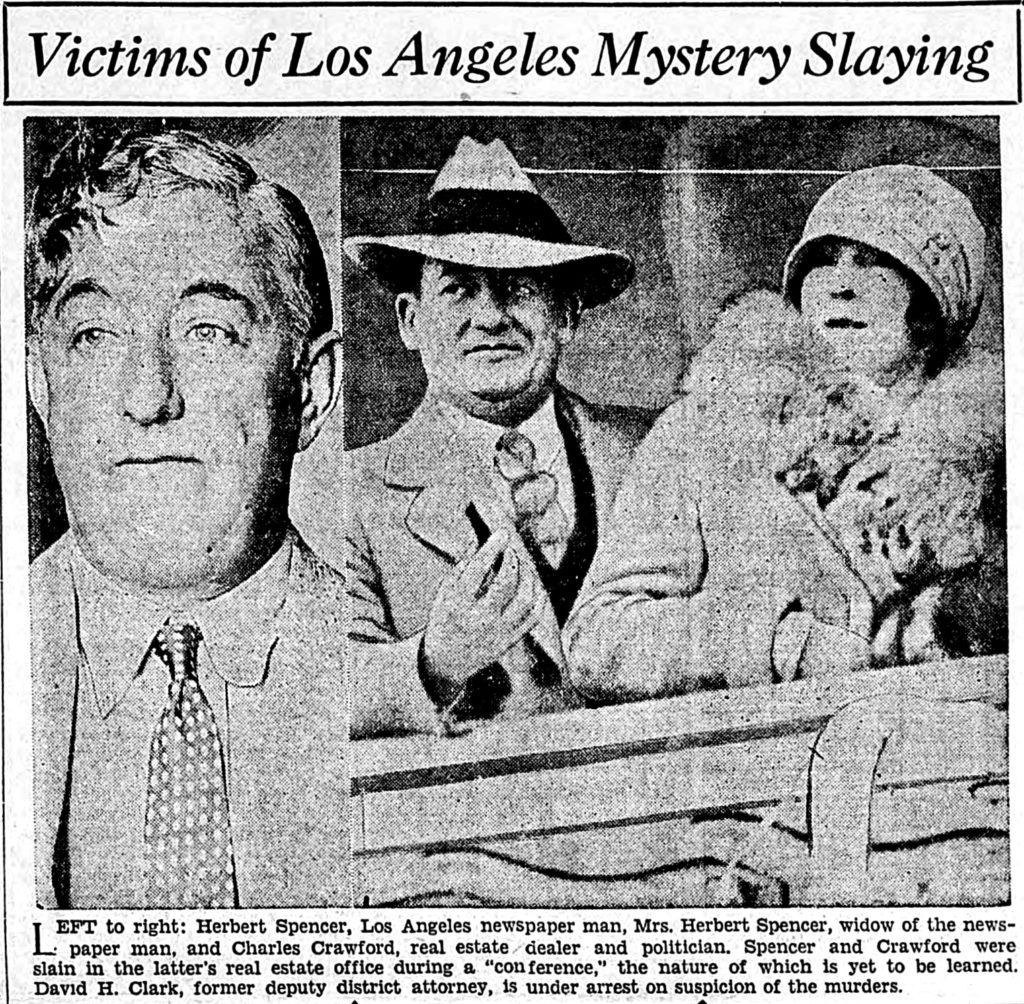
The authorities’ prime suspect had plenty of motive. Crawford and his former crime partner, ex-vice squad cop, Guy McAfee, had recently stopped being friendly. Papers coined McAfee a Crawford lieutenant. Although they’d parted way, Crawford couldn’t see fit to leave it at that. It was Good Time feeding the words to Spencer at the paper. And once printed, the articles spurred the double murder.
“A series of articles recently had been written by Spencer for the magazine in which he named a former police officer as the Al Capone of Los Angeles and attempted to reveal gang activities here.”
Not long after the smear hit newsstands, Spencer received a threat. And it wasn’t idle. Conveniently, McAfee had an alibi for the time of the murder though, and solidifying his innocence, three days later an unlikely confession surfaced. Throwing another odd twist to the plot, the murderer who stepped into the office of D.A. Buron Fitts to admit guilt, was a candidate for the municipal bench—former LA Deputy D.A. David Clark. Dave Clark, known by newsmen as “Handsome” and “Debonair Dave,” claimed self-defense, stating pistols were drawn at the “height of a political quarrel.”
District Attorney Buron Fitts elected not to play a formal role in the proceedings that followed. And he opted out for a very good reason; for seven years, Dave Clark worked under him. If the defense could prove that Fitts was unable to be objective, their prior relationship would have hampered the prosecution. For that reason, the D.A. wasn’t willing to gamble. Filling in for Fitts to vie as Handsome Dave’s opposition, was Special Prosecutor Joseph Ford. The graying veteran attorney hit hard at the courthouse, putting on a stellar performance. Dirtying Clark’s reputation with all he had, he alleged that the accused was “closely allied with the underworld and its machinations” and feared the “Crawford-Spencer-Fitts clean-up plan” would blast “his political hopes,” robbing him of his “opportunity to rule as an underworld judge.” Throwing a halo over Good Time Charlie, Ford went on about the racketeer’s recent turn of the leaf, selling the story that he’d “joined the church and decided to work for the good of the community.”
Even now, the events that transpired in Charlie Crawford’s office that early evening in 1931 remain murky. Although more modern takes claim the political boss was holding a cigar rather than a pistol, little circulated details about the shooting suggest another story. Crawford wore an empty holster when he arrived at the hospital, for example. On the scene before police, Charlie’s bodyguard brother had plenty of time to take the iron into his possession. But the reformed racketeer’s weapons would later make a courtroom appearance.
Whether or not Crawford drew upon his assailant wasn’t the only aspect of the crime that remained in question. Though he confessed to the killing, some simply did not believe David Clark pulled the trigger. The list of doubtful included Jack Spencer, the 25 year old son of the deceased. “It was someone from the underworld,” the younger Spencer expressed to reporters, adding: “Dad knew too much about crime conditions.” Three months before the killing, Spencer admitted to his son “he had information to expose corruption and crime in Los Angeles and had received threatening letters.” Crawford, who funded the Spencer led paper, may have been the mouthpiece providing the intel. But if the gunman wasn’t Clark—and Clark, without question, was present when lead ripped through the organs of two men, claiming their lives—then who did the killing? And why would a candidate for Judge take the wrap?
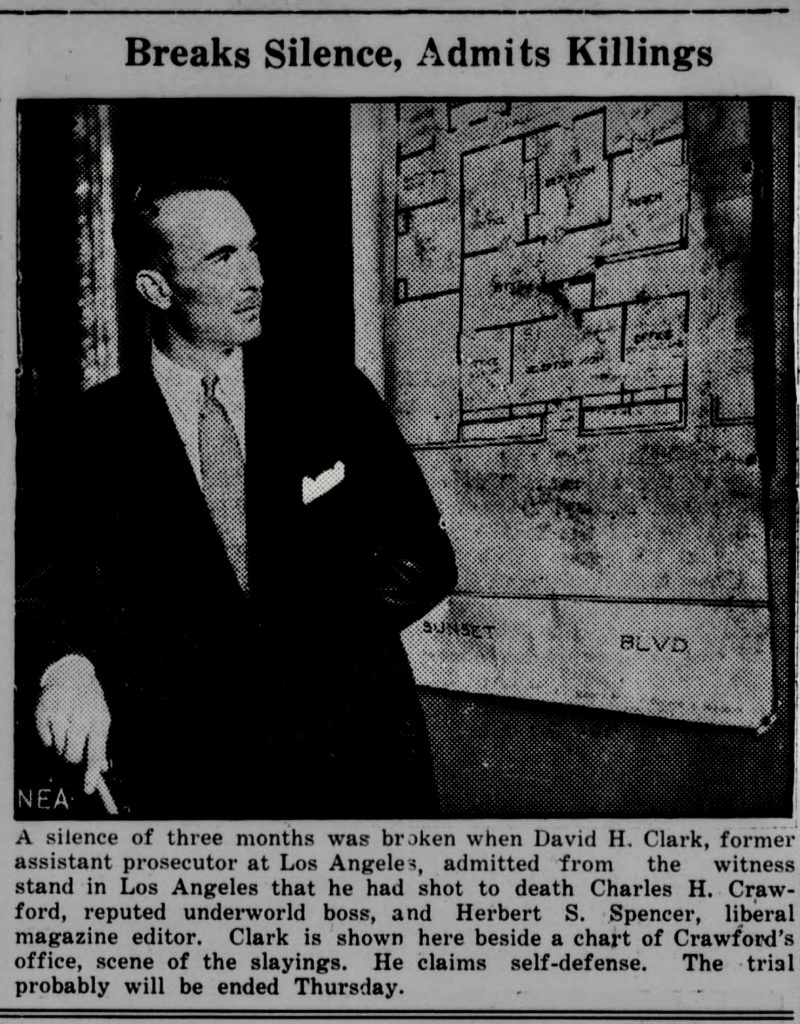
On the stand, ballistics expert Spencer Moxley testified “it was not possible to tell whether the bullets that killed Crawford and Spencer were fired from the same gun.” This allowed for a jaw dropping question—was there more than one shooter? Despite the possibility, Clark stuck to his story. They had an argument. They both drew. He shot in self-defense. “Fighting Bob” Shuler, the religious L.A. superpower with a controversial newspaper press of his own, commented on the new angle. Via his popular radio show, Shuler announced he “did not believe the two men had been shot by one person.” In line with what Jack Spencer told newsmen, Shuler also indicated the elder Spencer had recently confided he was holding onto some documents of interest. Spencer, he exclaimed, possessed evidence which could expose “political graft and the underworld racket.” Shuler offered little more though, saying they never had an opportunity to discuss the finer details.
Using a photo of Clark he’d taken from a judicial campaign ad running in the papers, D.A. Buron Fitts approached three eyewitnesses. Each indicated the man in the photograph looked an awful lot like the assailant they saw fleeing. Only one would say for certain on the stand though. Positively identifying Clark as the assailant was George Crawford. Given his relation to the deceased, his word held little weight. They impeached his testimony. More interestingly; however, was a new version of the story that stated multiple individuals fled the scene.
“William E. French, described as a new material witness…told detectives he heard the sound of shots coming from Crawford’s office and saw three men run from the building.” Giving credit to the account, “his story tended to substantiate that of Jean Riley, film actress.” Although it’s not uncommon for citizens to flee at the blare of a gun, it is a bit suspicious considering the detectives who questioned Crawford just before his passing, swear he admitted “two men had walked in and started shooting.”
An accurate depiction of what transpired in that small room so many years back might never be given. It would seem we have a handful of pieces belonging to separate puzzles. Dave Clark survived two trials over the murder of Herbert Spencer. Jurors couldn’t agree during either. Shockingly, in between courtroom bouts, the judge agreed to release the accused on $30,000 bail. Clark may just be the first man charged with murder to ever receive bail in the City of Angels. Though eventually acquitted, Clark’s battle was only halfway over; another killing still hung over the head of Handsome Dave.
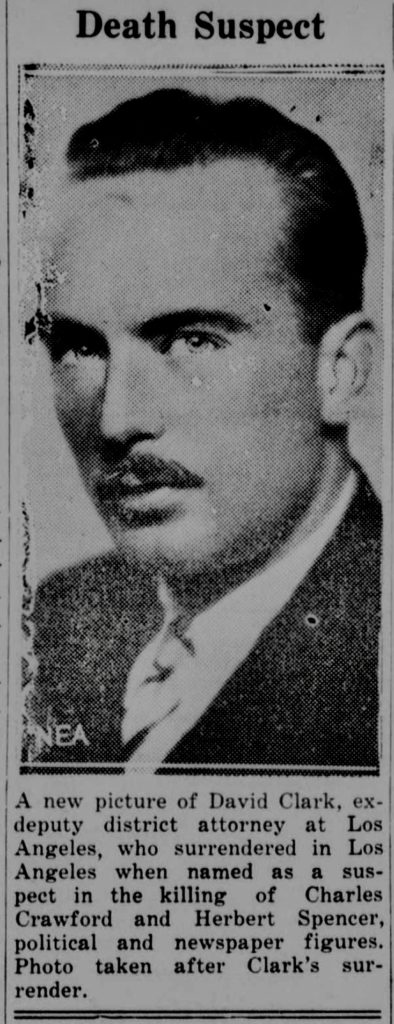
The charge for laying low Charlie Crawford had been in a stall, pending over the outcome of the Spencer trial. But no one would ever stand before a judge for killing Good Time Charlie. Strangely, his widow asked Buron Fitts to “abandon” the effort. Rather coldly, she admitted having “no confidence in Fitts’ or Special Prosecutor Joe Ford’s ability to obtain a conviction.” The D.A.’s office dropped the charges over the Charlie Crawford murder.
Some believed Guy McAfee orchestrated the entire fiasco, using poor Dave Clark as a pawn to set up Crawford for the hit. It is certainly of interest to know that after it all ended, the former deputy district attorney left his practice to come work for McAfee.
Less than two months before Charlie Crawford’ slaying, the first of two failed attempts on the life of LA Crime Boss Joe Ardizzone occurred. No mere coincidence, he would disappear for good one month after the brutal demise of Salvatore Maranzano. Right around the time Handsome Dave Clark was tasting acquittal, Alphonse Capone suffered a rather harsh sentencing: seventeen years in prison for failing to pay his taxes. Opening the door to a nationwide shift, was the void left by the absence of five powerful crime bosses—Crawford on the side of the non-Italian Combination, and Masseria, Maranzano, Capone, and Ardizzone as heads of various Italian colonies. A younger minded generation stepped in to head corruption up.
Life did not remain quiet for Dave Clark. Before the close of the decade, his wife left him. In the years that followed, he suffered from the bottle, depression, and thoughts of swallowing a pistol. But in the end, it wasn’t his own life that Handsome Dave Clark would take. In 1953, he fired a 12-gauge at the wife of his former law partner. George Blair may have been Dave’s last and only friend. Down on his luck, unemployed Dave had been staying at the Blair residence. Not too happy about the arrangement, Blair’s wife, Rose, showed Clark no kindness during his stay. Long walking the breaking point, the former Deputy D.A. doubled her over with a shotgun in the backyard one morning. Handsome Dave only served three weeks of a five to life sentence. A brain hemorrhage is how it ended.
For further reading: Resting on my shelf is an unread and newly purchased copy of A Bright and Guilty Place: Murder, Corruption, and L.A.’s Scandalous Coming of Age, by Richard Rayner. The true crime title looks exclusively at the Crawford-Spencer-Clark murder trial.
- The Walnut Bust: The Early Days of Los Angeles With Dr J. Michael Niotta - May 21, 2020
- The Cornero Gang & the Infamous Page Brothers: The Early Days of Los Angeles With Dr J. Michael Niotta - June 4, 2019
- The Man From Chicago: The Early Days of Los Angeles With Dr J. Michael Niotta - December 12, 2018






